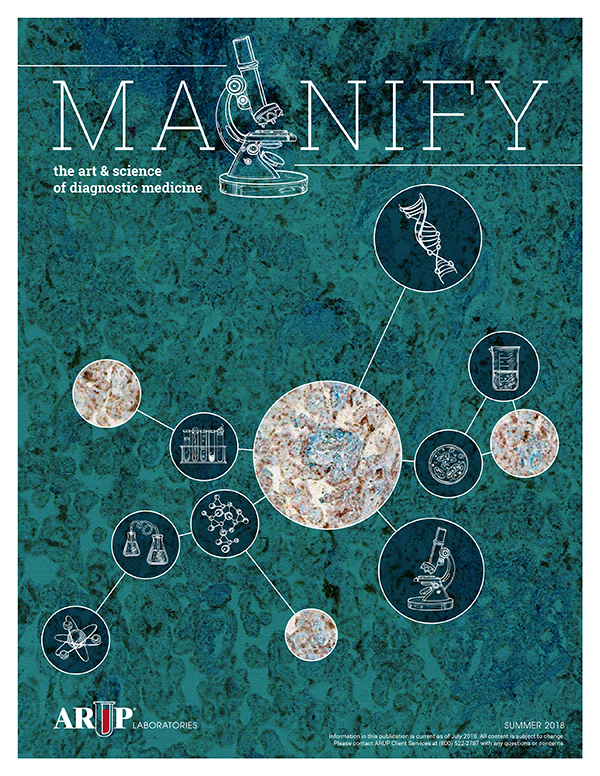How ARUP Healthcare Advisory Services Helped Fairview Health Services Build a Robust Laboratory Stewardship Program
As a national reference laboratory, ARUP Laboratories has an innate and thorough understanding of complex lab operations. ARUP Healthcare Advisory Services draws on this knowledge to help clinical laboratories deliver value-based care and achieve long-term revenue goals for their health systems.
Healthcare Advisory Services consultants are seasoned lab leaders and data analysts who offer an expansive portfolio of customizable offerings in areas such as lab stewardship, outreach operations, analytics and reporting, lab/system alignment, and more.
Here, we take an in-depth look at how Healthcare Advisory Services helped a client develop an effective laboratory stewardship committee. In future issues of Magnify, we’ll continue to feature client success stories that highlight Healthcare Advisory Service’s impactful, tailored solutions.
Laying the Groundwork for Laboratory Stewardship
Fairview Health Services, a Midwestern health system with 13 hospitals and 142 overall locations, is committed to improving health and well-being in the communities it serves. With that mission in mind, Fairview sought to improve its laboratory ordering practices to support appropriate care while optimizing the use of valuable laboratory resources. The health system partnered with ARUP Healthcare Advisory Services to establish a dynamic, effective laboratory stewardship committee and to provide an integrated data source to inform and benchmark the committee’s efforts.
Healthcare Advisory Services consultants helped Fairview develop a successful laboratory stewardship program by:
- Recommending a governance structure
- Delivering a comprehensive data solution
- Analyzing system data to identify opportunities
- Prioritizing interventions and identifying next steps
- Providing continuing support
Stewardship Governance
The first step in creating a laboratory stewardship program is developing a charter document that specifies objectives, stewardship committee membership, and processes. Healthcare Advisory Services consultants provided Fairview with charter suggestions and examples from other organizations. This helped Fairview develop a charter that best met its unique needs.
Laboratory stewardship committees need clear objectives to ensure their efforts are focused and efficacious. Eliminating waste and achieving cost savings are common objectives. “But we intentionally named ourselves a stewardship committee and not a utilization committee,” said Klint Kjeldahl, CT(ASCP), vice president of Laboratory Services at Fairview Health Services and a member of the stewardship committee. “Our goals really help to guide us toward appropriate test utilization, which doesn’t always mean that you’re reducing the number of tests. It’s truly [about] the more appropriate use.”
Healthcare Advisory Services consultants recommended that the Fairview team establish a clinician-led rather than a laboratory-led committee. Clinicians are the end users of laboratory services, so their concerns and priorities need to drive stewardship efforts. Additionally, when clinicians are spearheading changes, they can champion those initiatives throughout a system’s clinical community.
“It’s not just problems we’re seeing from a laboratory perspective. It’s problems our entire system is seeing,” Kjeldahl explained. “Yes, laboratorians still have strong influence on the committee, but clinicians help us see through different eyes the various problems, opportunities, and potential solutions.”
Fairview took a multidisciplinary approach to creating its laboratory stewardship committee, seeking involvement from clinicians as well as pharmacy, quality, operations, finance, nursing, IT, and other departments. This broad representation enables Fairview’s laboratory stewardship committee to better understand the systemwide implications of its work. It has also helped to bring new ideas to the team.
Comprehensive Data

Not long after launching its laboratory stewardship program, Fairview committee members realized they didn’t have the detailed data needed to identify ordering trends or misutilization. The committee chose to implement ARUP AnalyticsDx™ (ADx) Comprehensive to gather that crucial data and uncover ideas for stewardship projects.
ADx Comprehensive gathers disparate system data into one seamless database. Easy-to-use dashboards enable leaders to filter test orders in a variety of ways so that they can establish baselines and monitor the impact of interventions.
“Change is really difficult. Even making a small change can take an intense, coordinated effort, and we cannot afford to waste the limited resources we have to make change,” said Michelle Stoffel, MD, PhD, associate chief medical information officer for Laboratory Medicine and Pathology at Fairview Health Services and a member of the stewardship committee. “Having even a small amount of meaningful data is much more important than having large amounts of useless data.”
Fairview worked closely with ARUP to build new ADx Comprehensive dashboards that provided the data views Fairview most needed. “It was really helpful to partner with ARUP on the data mapping,” Stoffel said. “We learned a lot about our own data, as well as how it could optimally be mapped into the ADx Comprehensive dashboards in a way that makes sense for the questions we wanted to ask.”
The Fairview team has found that ADx Comprehensive is an important part of the lab’s overall data analysis ecosystem, complementing other data tools while giving unique insights not provided by other tools. “We, like many laboratory systems, have several reporting options in our toolkit, including our native EHR [electronic health record] reporting and enterprise-level solutions. However, the ADx Comprehensive dashboards provide powerful visuals of clinical best practices applied to our data in a way that facilitates change conversations with stakeholders,” Stoffel said.
As an example, Stoffel used the automated visuals provided by the ADx Comprehensive dashboards to demonstrate the need to improve daily lab utilization to Fairview’s medical informatics leadership team. “The visuals helped to tell the story in a way clinicians could instantly connect with,” she said. “Because we use the dashboard data to augment our other enterprise reporting data, which clinicians are already familiar with, our stakeholders can easily see how the stewardship-focused views fit into the bigger data picture.”
Data Analysis and Opportunities
The ADx Comprehensive dashboards give the Fairview laboratory stewardship committee a high-level view of ordering trends. “They let us see those big ordering patterns emerge, and I’ll be honest, we’ve had a few moments in our stewardship committee where we couldn’t believe what we were seeing. But that leads us to go look at our EHR build and our ordering reports. And there have been several instances where we have uncovered workflows that can be optimized,” Stoffel said.
For example, using the ADx Comprehensive dashboards, the Fairview laboratory stewardship committee discovered that some clinicians were still ordering a creatine kinase-muscle/brain (CK-MB) test to detect acute coronary syndrome (ACS). However, clinical guidelines call for a high-sensitivity cardiac troponin test to identify a superior biomarker for detection of ACS. To prevent this misutilization of the CK-MB test, the laboratory stewardship committee had it removed from Fairview’s test formulary.
Shortly after Fairview implemented ADx Comprehensive, Healthcare Advisory Services completed a utilization analysis that encompassed 12 months of laboratory data such as daily labs, duplicate orders, continuity of care information, sepsis testing protocols, and more. This analysis helped Fairview identify areas of opportunity for improvement.
Prioritization and Next Steps

The Fairview laboratory stewardship committee has been active for three years now. As its work becomes more visible and impactful, stakeholders throughout the organization are beginning to come to the committee with ideas.
“We’re at the point now where, happily, I’m getting pathology colleagues emailing me, referring their clinical colleagues who want to see a change or want to initiate a project,” Stoffel said. “Having clinical engagement really helps fuel the work because it lends visibility—folks tell their friends and then they know where to find us through their laboratory colleagues.”
The Fairview laboratory stewardship committee is in the process of launching a portal that will allow anyone in the organization to submit suggestions for stewardship projects or offer potential solutions to challenges.
Meanwhile, the committee must prioritize the initiatives that will make the greatest impact and keep the team focused on its overall objectives. Some of the current initiatives the Fairview stewardship committee is working on include:
Changes to daily lab ordering: Fairview’s utilization analysis found that 70% of inpatients had CBC and metabolic panel (MP) testing every day of their stay. Furthermore, much of this testing was duplicative, with 90% of CBCs and 75% of MPs being collected within 12 hours of the previous tests. The committee is launching a project to design and implement EHR ordering constraints that will limit the number of occurrences a provider can request for ongoing daily labs.
Timed-draw workflow changes: Some tests, such as tests to assess drug levels, need to be performed within specific time frames. Tests performed outside of the time frame are essentially wasted and may require specimens to be redrawn. Fairview is working to update its handheld patient identification system to prevent such tests from displaying until it’s the right time to order them. This initiative is an example of how broader stakeholder representation, in this case, from the pharmacy, has optimized the stewardship committee’s work.
Continuity of care committee creation: When tests are ordered for patients shortly before discharge from acute care, the patients may not receive follow-up on their results. Fairview’s utilization analysis found that over the course of a year, 99,277 test results (excluding cultures) arrived postdischarge. Fairview’s laboratory stewardship committee began developing a continuity of care subcommittee to address that gap in care. However, the team realized the subcommittee’s work would transcend the laboratory and touch on continuity between different care teams, scheduling teams, other departments, the EHR, and the laboratory. Although the concept of a continuity of care subcommittee originated with the laboratory stewardship committee, it has become a systemwide initiative.
Test code oversight: When creating new test codes, a test code process team at Fairview now consults with the laboratory stewardship committee to consider impacts on stewardship.
Continuing Involvement
Healthcare Advisory Services consultants have remained highly engaged with the Fairview laboratory stewardship committee. The consultants attend the committee’s monthly meetings, bringing a wider perspective and constructive suggestions to its work.
“The key benefit of having ARUP in the stewardship process is really that high-level institutional perspective,” Stoffel said. “ARUP consultants have seen it all.”
She added, “Having ARUP consultants as partners provides stability and accountability. They’ve provided that consistent forward momentum that can be really difficult to otherwise achieve when committee members rotate or when daily challenges become overwhelming.”
Through its continuing engagement with Healthcare Advisory Services, Fairview’s laboratory stewardship committee has become a robust engine for positive change. “What’s been most powerful is the ability to find those improvement sweet spots that are operationally valuable, as well as clinically meaningful to the patient,” Stoffel said.




